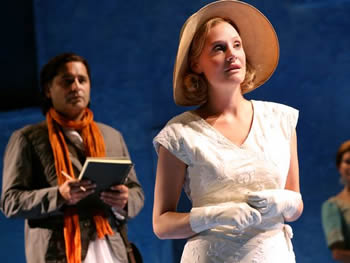HotReview.org Editor's
Picks
Shows Worth Seeing:

Indian Ink
By Tom Stoppard
Laura Pels Theater
111 W. 46th St.
TICKETS
Tom Stoppard made his reputation as a dramaturgical daredevil who could juggle multiple oddly matched dramatic objects while balancing on an intellectual tightrope. Travesties, Jumpers, Rosencrantz and Guildenstern are Dead, Arcadia: these are examples of the trick working brilliantly, when he pulled off the feat of blending complex ideas, unlikely characters and far-flung narrative threads in a way that fascinated, delighted and crackled with provocative energy. In other plays, he hasn’t quite pulled the trick off. The Coast of Utopia, The Invention of Love, and Rock and Roll are works where the prodigious historical research hung limp as drama, and the ostensibly mad mixture of characters, ideas and narrative threads proved heavy rather than whimsical and never quite found a credible chemistry.
It's possible that Stoppard knows this, because in still other plays—The Real Thing and Dogg’s Hamlet, for instance—he has concentrated on the emotional encounters of his characters rather than their theories of history or art (though these are still present), with powerful if relatively conventional results. In trying to do less, he achieves more, which is certainly the case with Indian Ink, 1995 play, now receiving its first major New York production, that has been occasionally described as Arcadia-lite. That is true enough but not as damning as it sounds. The plot, like Arcadia’s, toggles back and forth between two time periods: the 1930s in India and the 1980s in India and England, while telling the story of an English poet named Flora Crewe (Romola Garai) and her encounter with a handsome, widowed Indian painter named Nirad Das (Firdous Bamji). Half a century later, Crewe’s elderly sister (Rosemary Harris), Das’s son (Bhavesh Patel) and an academic biographer (Neal Huff) try variously to reconstruct the truth of the 1930s encounter while everyone detours into subjects as diverse and heady as the Sanskrit concept of rasa, the early 19th-century travel journals of Lady Sale, and modern concepts of realism.
Unlike Arcadia, however, the charm in Indian Ink rests only superficially on its ideas, which merely flit about like innocuous moths. It’s the irresistible character of Flora, with her unfailing amiability, disarming candor, and utterly guileless artistic investment in eroticism that sustains the drama and gives it lift and human heft. The role is perfectly cast here (the production is directed by Carey Perloff). Garai has just the right oblique allure to justify her pushy questions to Das and her constant, sensuous wordplay without ever falling into wryness or cynicism. The delicacy of the love story requires a worldly-wise Aryan beauty who never shades into Marlene Dietrich—she must be a wholly ingenuous adventurer who comes off as neither naïve nor aggressive but nevertheless wins everyone's heart. This is the chemical reaction Garai pulls off, and it’s well worth witnessing.
